Critical Evaluation of German Business Environment for Loynds
VerifiedAdded on 2022/11/26
|14
|2924
|129
AI Summary
This report provides a critical evaluation of the aspects of the business environment of Germany for Loynds, a small UK manufacturing unit, to analyze the decision of relocating to Germany and internationalize. It includes an overview of the market, factors to consider before making entry, convenience of doing business in Germany, access to supplies and export of goods, and finding the required skills. The report concludes that Germany provides an ideal ambience for Loynds to flourish.
Contribute Materials
Your contribution can guide someone’s learning journey. Share your
documents today.
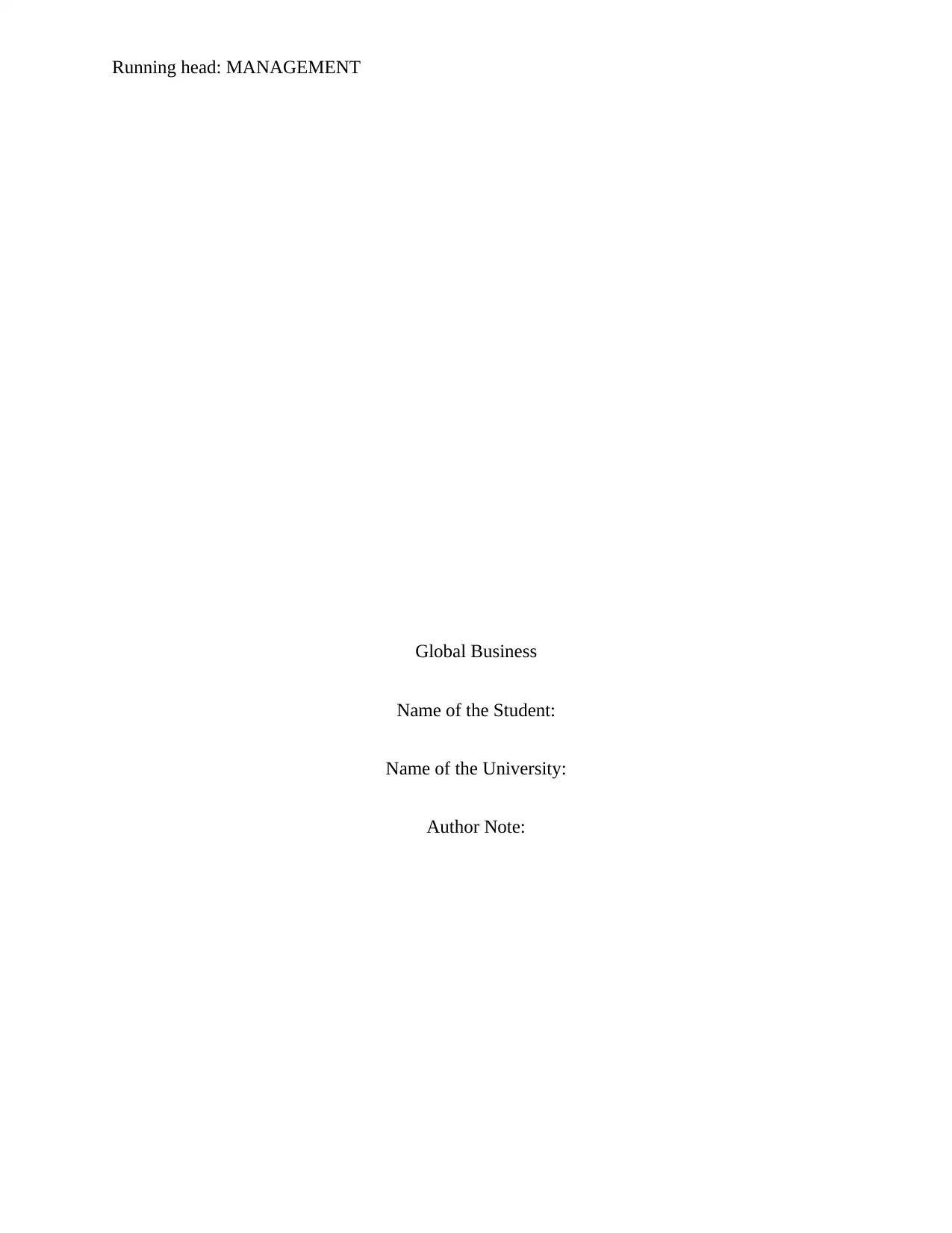
Running head: MANAGEMENT
Global Business
Name of the Student:
Name of the University:
Author Note:
Global Business
Name of the Student:
Name of the University:
Author Note:
Secure Best Marks with AI Grader
Need help grading? Try our AI Grader for instant feedback on your assignments.
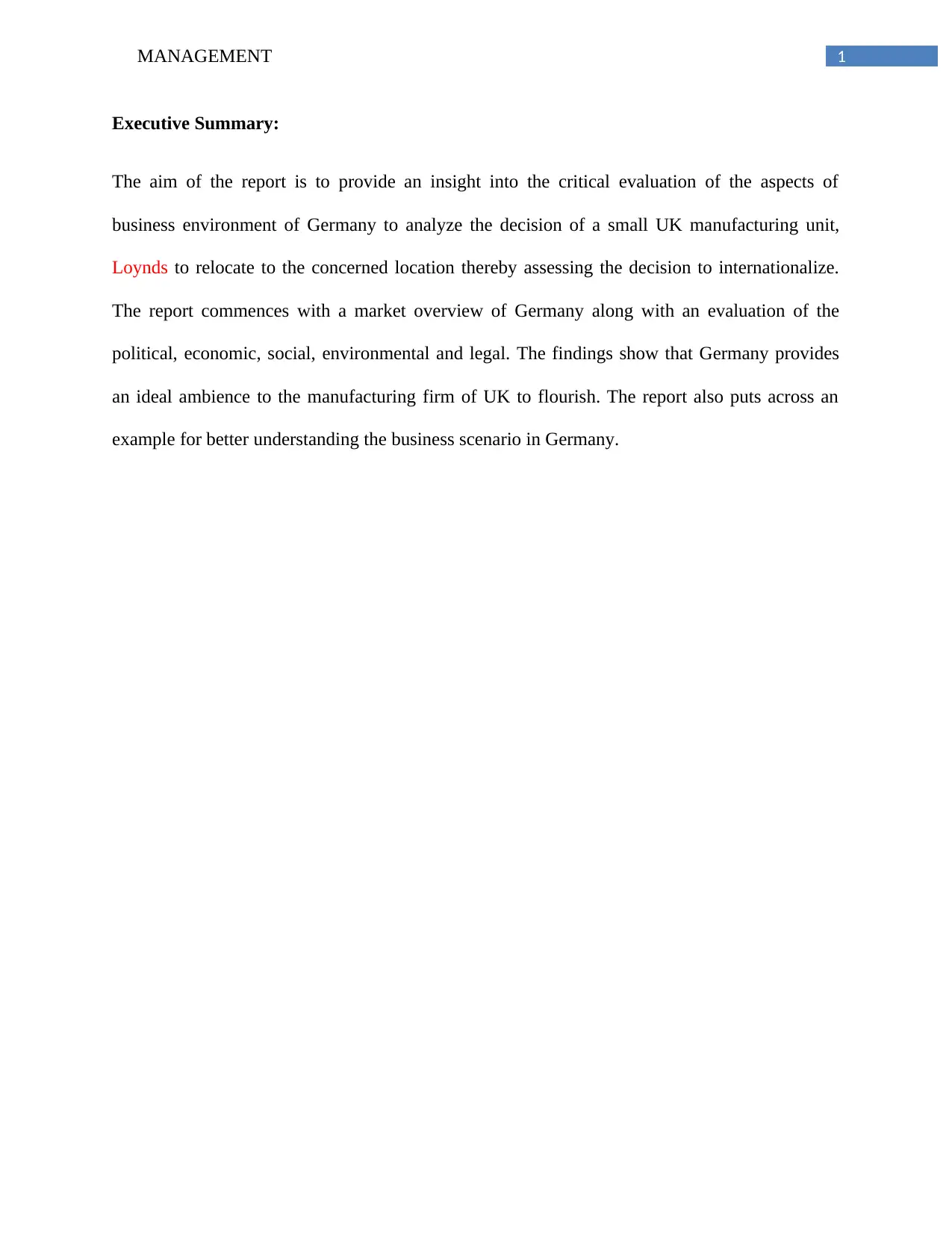
1MANAGEMENT
Executive Summary:
The aim of the report is to provide an insight into the critical evaluation of the aspects of
business environment of Germany to analyze the decision of a small UK manufacturing unit,
Loynds to relocate to the concerned location thereby assessing the decision to internationalize.
The report commences with a market overview of Germany along with an evaluation of the
political, economic, social, environmental and legal. The findings show that Germany provides
an ideal ambience to the manufacturing firm of UK to flourish. The report also puts across an
example for better understanding the business scenario in Germany.
Executive Summary:
The aim of the report is to provide an insight into the critical evaluation of the aspects of
business environment of Germany to analyze the decision of a small UK manufacturing unit,
Loynds to relocate to the concerned location thereby assessing the decision to internationalize.
The report commences with a market overview of Germany along with an evaluation of the
political, economic, social, environmental and legal. The findings show that Germany provides
an ideal ambience to the manufacturing firm of UK to flourish. The report also puts across an
example for better understanding the business scenario in Germany.
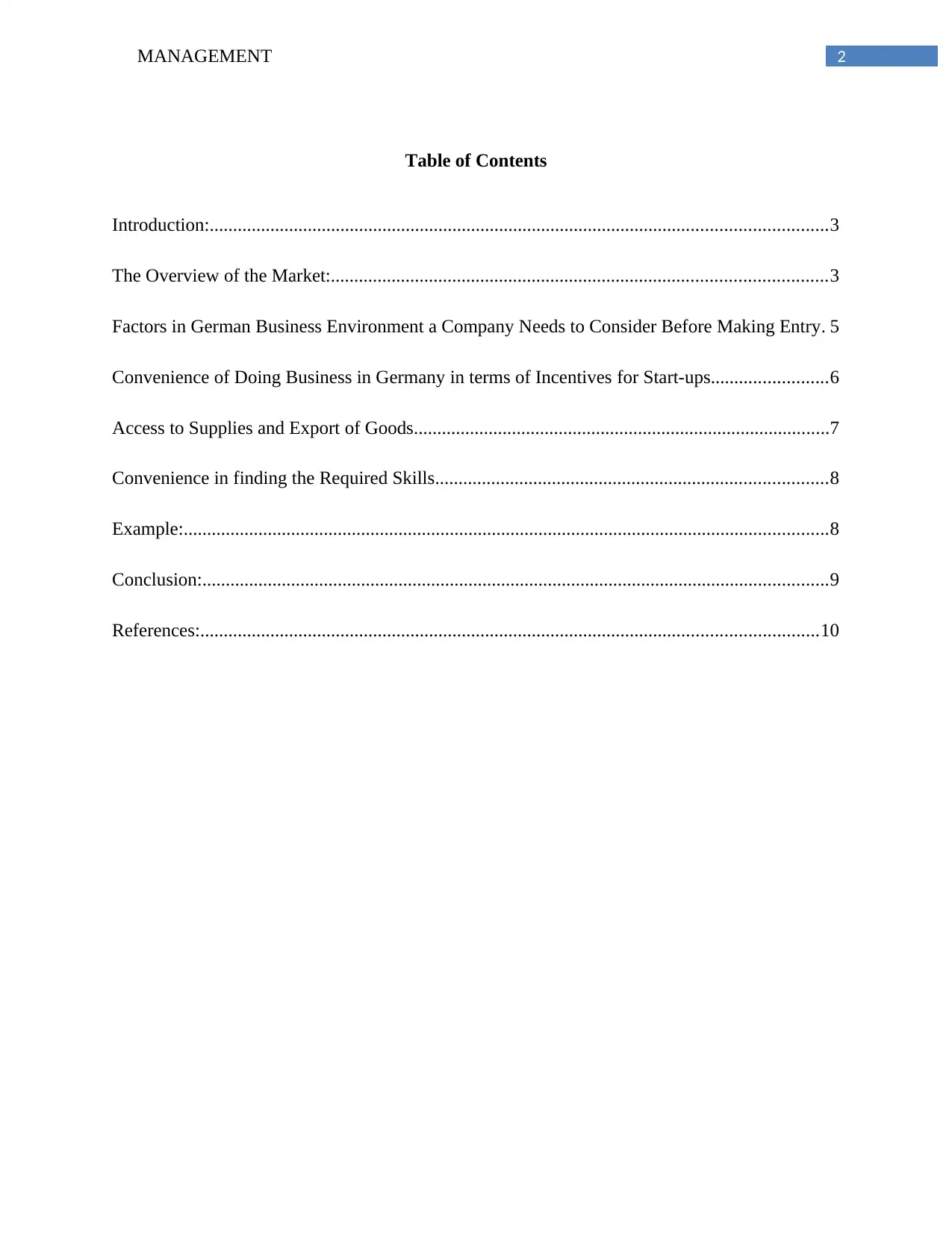
2MANAGEMENT
Table of Contents
Introduction:....................................................................................................................................3
The Overview of the Market:..........................................................................................................3
Factors in German Business Environment a Company Needs to Consider Before Making Entry. 5
Convenience of Doing Business in Germany in terms of Incentives for Start-ups.........................6
Access to Supplies and Export of Goods.........................................................................................7
Convenience in finding the Required Skills....................................................................................8
Example:..........................................................................................................................................8
Conclusion:......................................................................................................................................9
References:....................................................................................................................................10
Table of Contents
Introduction:....................................................................................................................................3
The Overview of the Market:..........................................................................................................3
Factors in German Business Environment a Company Needs to Consider Before Making Entry. 5
Convenience of Doing Business in Germany in terms of Incentives for Start-ups.........................6
Access to Supplies and Export of Goods.........................................................................................7
Convenience in finding the Required Skills....................................................................................8
Example:..........................................................................................................................................8
Conclusion:......................................................................................................................................9
References:....................................................................................................................................10
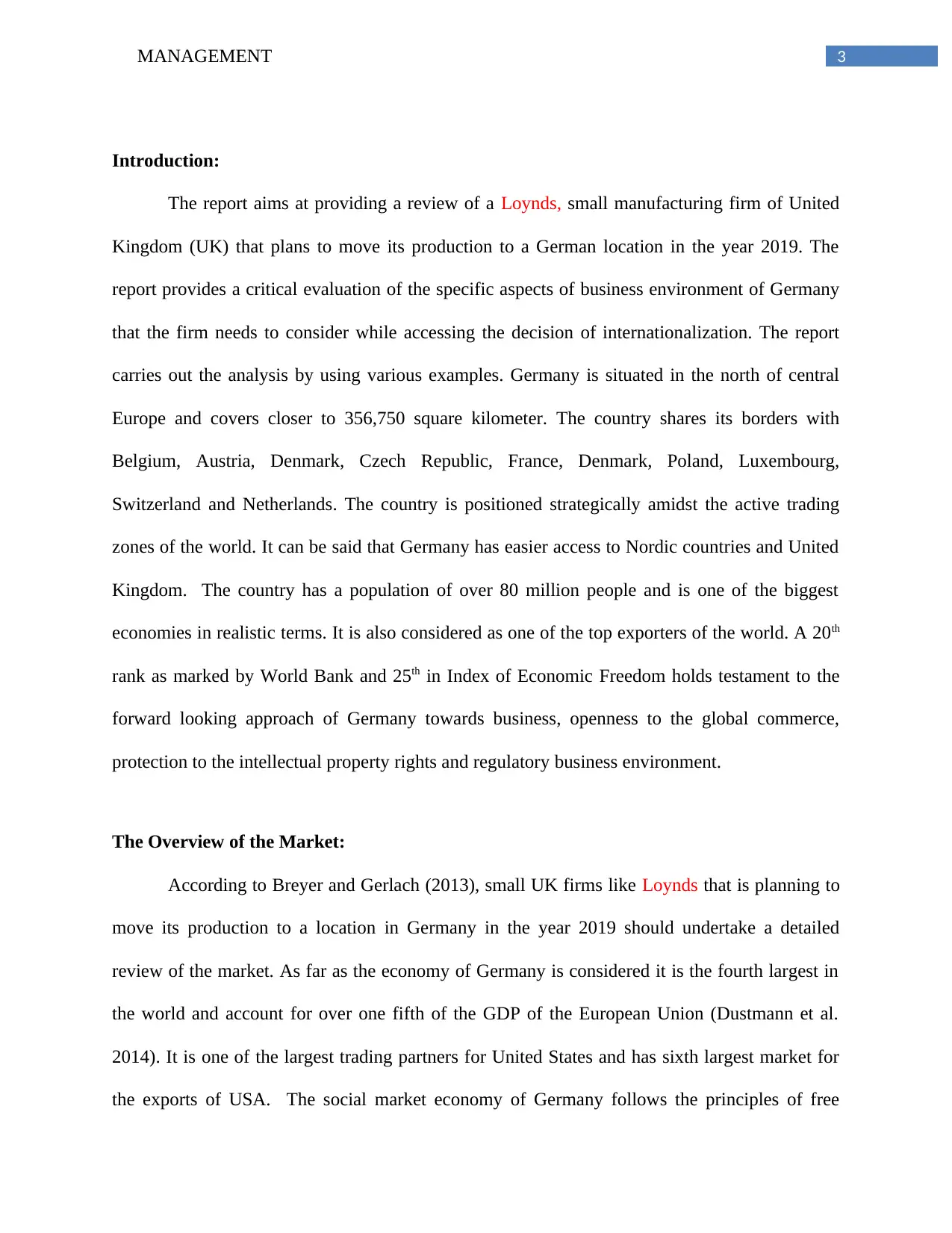
3MANAGEMENT
Introduction:
The report aims at providing a review of a Loynds, small manufacturing firm of United
Kingdom (UK) that plans to move its production to a German location in the year 2019. The
report provides a critical evaluation of the specific aspects of business environment of Germany
that the firm needs to consider while accessing the decision of internationalization. The report
carries out the analysis by using various examples. Germany is situated in the north of central
Europe and covers closer to 356,750 square kilometer. The country shares its borders with
Belgium, Austria, Denmark, Czech Republic, France, Denmark, Poland, Luxembourg,
Switzerland and Netherlands. The country is positioned strategically amidst the active trading
zones of the world. It can be said that Germany has easier access to Nordic countries and United
Kingdom. The country has a population of over 80 million people and is one of the biggest
economies in realistic terms. It is also considered as one of the top exporters of the world. A 20th
rank as marked by World Bank and 25th in Index of Economic Freedom holds testament to the
forward looking approach of Germany towards business, openness to the global commerce,
protection to the intellectual property rights and regulatory business environment.
The Overview of the Market:
According to Breyer and Gerlach (2013), small UK firms like Loynds that is planning to
move its production to a location in Germany in the year 2019 should undertake a detailed
review of the market. As far as the economy of Germany is considered it is the fourth largest in
the world and account for over one fifth of the GDP of the European Union (Dustmann et al.
2014). It is one of the largest trading partners for United States and has sixth largest market for
the exports of USA. The social market economy of Germany follows the principles of free
Introduction:
The report aims at providing a review of a Loynds, small manufacturing firm of United
Kingdom (UK) that plans to move its production to a German location in the year 2019. The
report provides a critical evaluation of the specific aspects of business environment of Germany
that the firm needs to consider while accessing the decision of internationalization. The report
carries out the analysis by using various examples. Germany is situated in the north of central
Europe and covers closer to 356,750 square kilometer. The country shares its borders with
Belgium, Austria, Denmark, Czech Republic, France, Denmark, Poland, Luxembourg,
Switzerland and Netherlands. The country is positioned strategically amidst the active trading
zones of the world. It can be said that Germany has easier access to Nordic countries and United
Kingdom. The country has a population of over 80 million people and is one of the biggest
economies in realistic terms. It is also considered as one of the top exporters of the world. A 20th
rank as marked by World Bank and 25th in Index of Economic Freedom holds testament to the
forward looking approach of Germany towards business, openness to the global commerce,
protection to the intellectual property rights and regulatory business environment.
The Overview of the Market:
According to Breyer and Gerlach (2013), small UK firms like Loynds that is planning to
move its production to a location in Germany in the year 2019 should undertake a detailed
review of the market. As far as the economy of Germany is considered it is the fourth largest in
the world and account for over one fifth of the GDP of the European Union (Dustmann et al.
2014). It is one of the largest trading partners for United States and has sixth largest market for
the exports of USA. The social market economy of Germany follows the principles of free
Secure Best Marks with AI Grader
Need help grading? Try our AI Grader for instant feedback on your assignments.
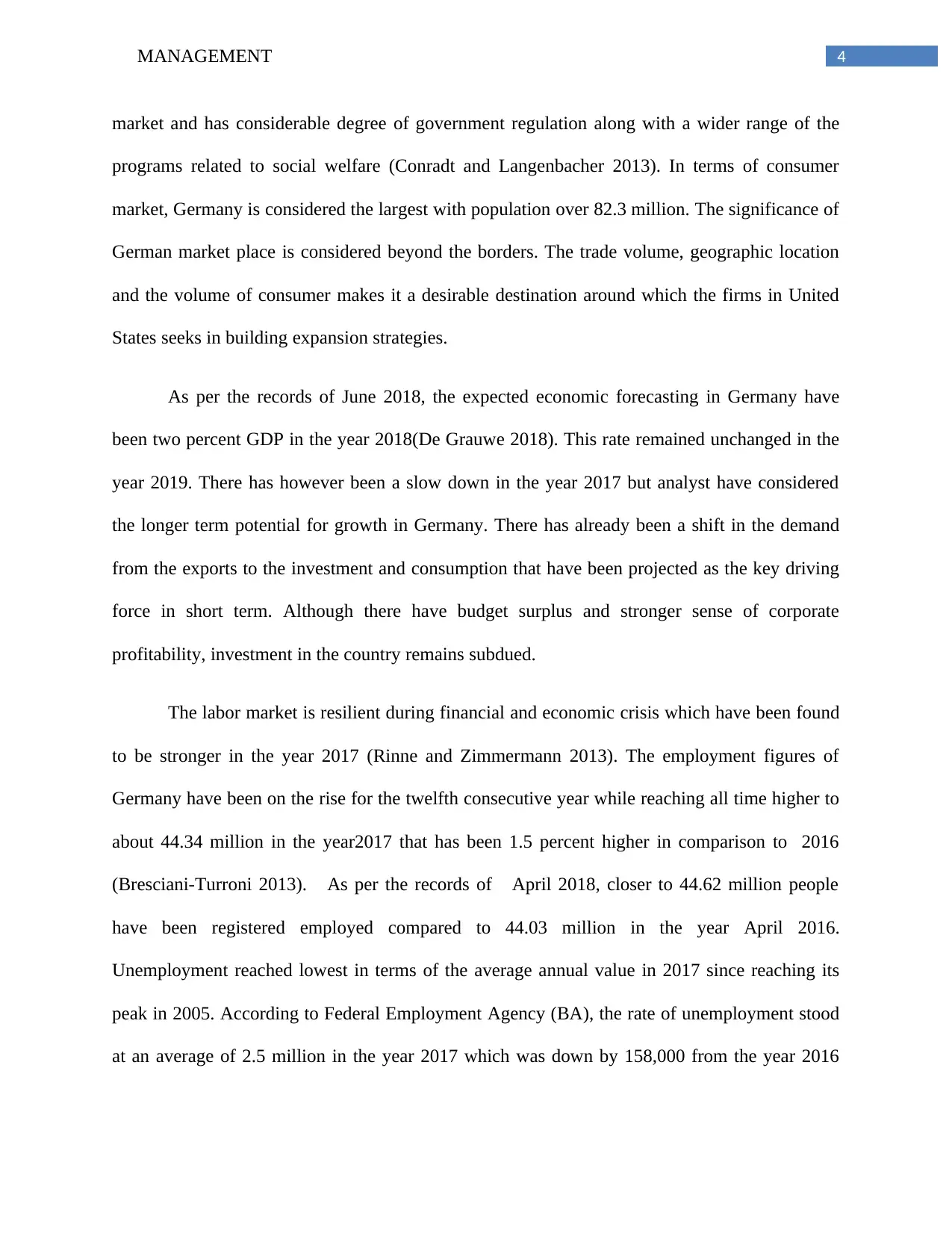
4MANAGEMENT
market and has considerable degree of government regulation along with a wider range of the
programs related to social welfare (Conradt and Langenbacher 2013). In terms of consumer
market, Germany is considered the largest with population over 82.3 million. The significance of
German market place is considered beyond the borders. The trade volume, geographic location
and the volume of consumer makes it a desirable destination around which the firms in United
States seeks in building expansion strategies.
As per the records of June 2018, the expected economic forecasting in Germany have
been two percent GDP in the year 2018(De Grauwe 2018). This rate remained unchanged in the
year 2019. There has however been a slow down in the year 2017 but analyst have considered
the longer term potential for growth in Germany. There has already been a shift in the demand
from the exports to the investment and consumption that have been projected as the key driving
force in short term. Although there have budget surplus and stronger sense of corporate
profitability, investment in the country remains subdued.
The labor market is resilient during financial and economic crisis which have been found
to be stronger in the year 2017 (Rinne and Zimmermann 2013). The employment figures of
Germany have been on the rise for the twelfth consecutive year while reaching all time higher to
about 44.34 million in the year2017 that has been 1.5 percent higher in comparison to 2016
(Bresciani-Turroni 2013). As per the records of April 2018, closer to 44.62 million people
have been registered employed compared to 44.03 million in the year April 2016.
Unemployment reached lowest in terms of the average annual value in 2017 since reaching its
peak in 2005. According to Federal Employment Agency (BA), the rate of unemployment stood
at an average of 2.5 million in the year 2017 which was down by 158,000 from the year 2016
market and has considerable degree of government regulation along with a wider range of the
programs related to social welfare (Conradt and Langenbacher 2013). In terms of consumer
market, Germany is considered the largest with population over 82.3 million. The significance of
German market place is considered beyond the borders. The trade volume, geographic location
and the volume of consumer makes it a desirable destination around which the firms in United
States seeks in building expansion strategies.
As per the records of June 2018, the expected economic forecasting in Germany have
been two percent GDP in the year 2018(De Grauwe 2018). This rate remained unchanged in the
year 2019. There has however been a slow down in the year 2017 but analyst have considered
the longer term potential for growth in Germany. There has already been a shift in the demand
from the exports to the investment and consumption that have been projected as the key driving
force in short term. Although there have budget surplus and stronger sense of corporate
profitability, investment in the country remains subdued.
The labor market is resilient during financial and economic crisis which have been found
to be stronger in the year 2017 (Rinne and Zimmermann 2013). The employment figures of
Germany have been on the rise for the twelfth consecutive year while reaching all time higher to
about 44.34 million in the year2017 that has been 1.5 percent higher in comparison to 2016
(Bresciani-Turroni 2013). As per the records of April 2018, closer to 44.62 million people
have been registered employed compared to 44.03 million in the year April 2016.
Unemployment reached lowest in terms of the average annual value in 2017 since reaching its
peak in 2005. According to Federal Employment Agency (BA), the rate of unemployment stood
at an average of 2.5 million in the year 2017 which was down by 158,000 from the year 2016
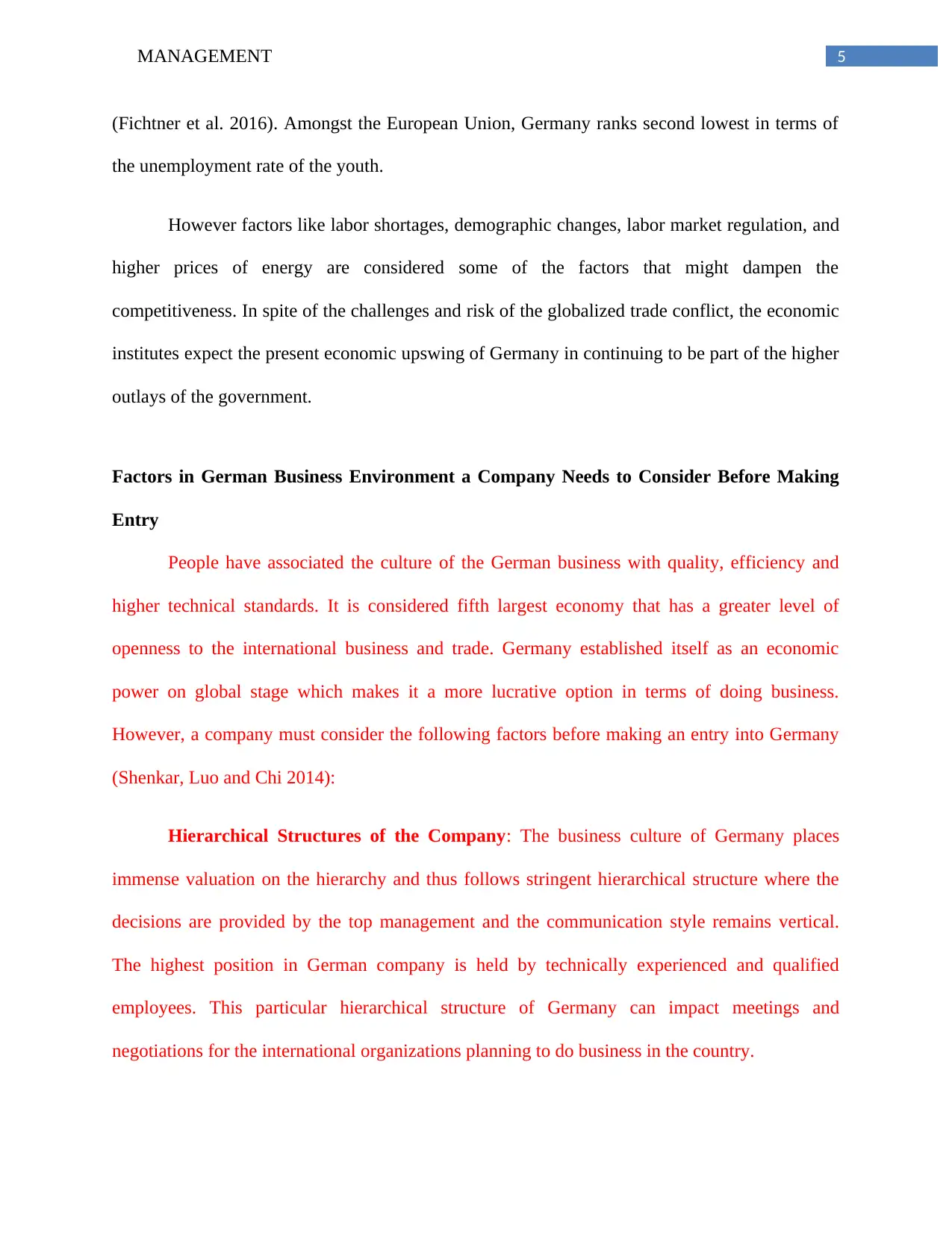
5MANAGEMENT
(Fichtner et al. 2016). Amongst the European Union, Germany ranks second lowest in terms of
the unemployment rate of the youth.
However factors like labor shortages, demographic changes, labor market regulation, and
higher prices of energy are considered some of the factors that might dampen the
competitiveness. In spite of the challenges and risk of the globalized trade conflict, the economic
institutes expect the present economic upswing of Germany in continuing to be part of the higher
outlays of the government.
Factors in German Business Environment a Company Needs to Consider Before Making
Entry
People have associated the culture of the German business with quality, efficiency and
higher technical standards. It is considered fifth largest economy that has a greater level of
openness to the international business and trade. Germany established itself as an economic
power on global stage which makes it a more lucrative option in terms of doing business.
However, a company must consider the following factors before making an entry into Germany
(Shenkar, Luo and Chi 2014):
Hierarchical Structures of the Company: The business culture of Germany places
immense valuation on the hierarchy and thus follows stringent hierarchical structure where the
decisions are provided by the top management and the communication style remains vertical.
The highest position in German company is held by technically experienced and qualified
employees. This particular hierarchical structure of Germany can impact meetings and
negotiations for the international organizations planning to do business in the country.
(Fichtner et al. 2016). Amongst the European Union, Germany ranks second lowest in terms of
the unemployment rate of the youth.
However factors like labor shortages, demographic changes, labor market regulation, and
higher prices of energy are considered some of the factors that might dampen the
competitiveness. In spite of the challenges and risk of the globalized trade conflict, the economic
institutes expect the present economic upswing of Germany in continuing to be part of the higher
outlays of the government.
Factors in German Business Environment a Company Needs to Consider Before Making
Entry
People have associated the culture of the German business with quality, efficiency and
higher technical standards. It is considered fifth largest economy that has a greater level of
openness to the international business and trade. Germany established itself as an economic
power on global stage which makes it a more lucrative option in terms of doing business.
However, a company must consider the following factors before making an entry into Germany
(Shenkar, Luo and Chi 2014):
Hierarchical Structures of the Company: The business culture of Germany places
immense valuation on the hierarchy and thus follows stringent hierarchical structure where the
decisions are provided by the top management and the communication style remains vertical.
The highest position in German company is held by technically experienced and qualified
employees. This particular hierarchical structure of Germany can impact meetings and
negotiations for the international organizations planning to do business in the country.
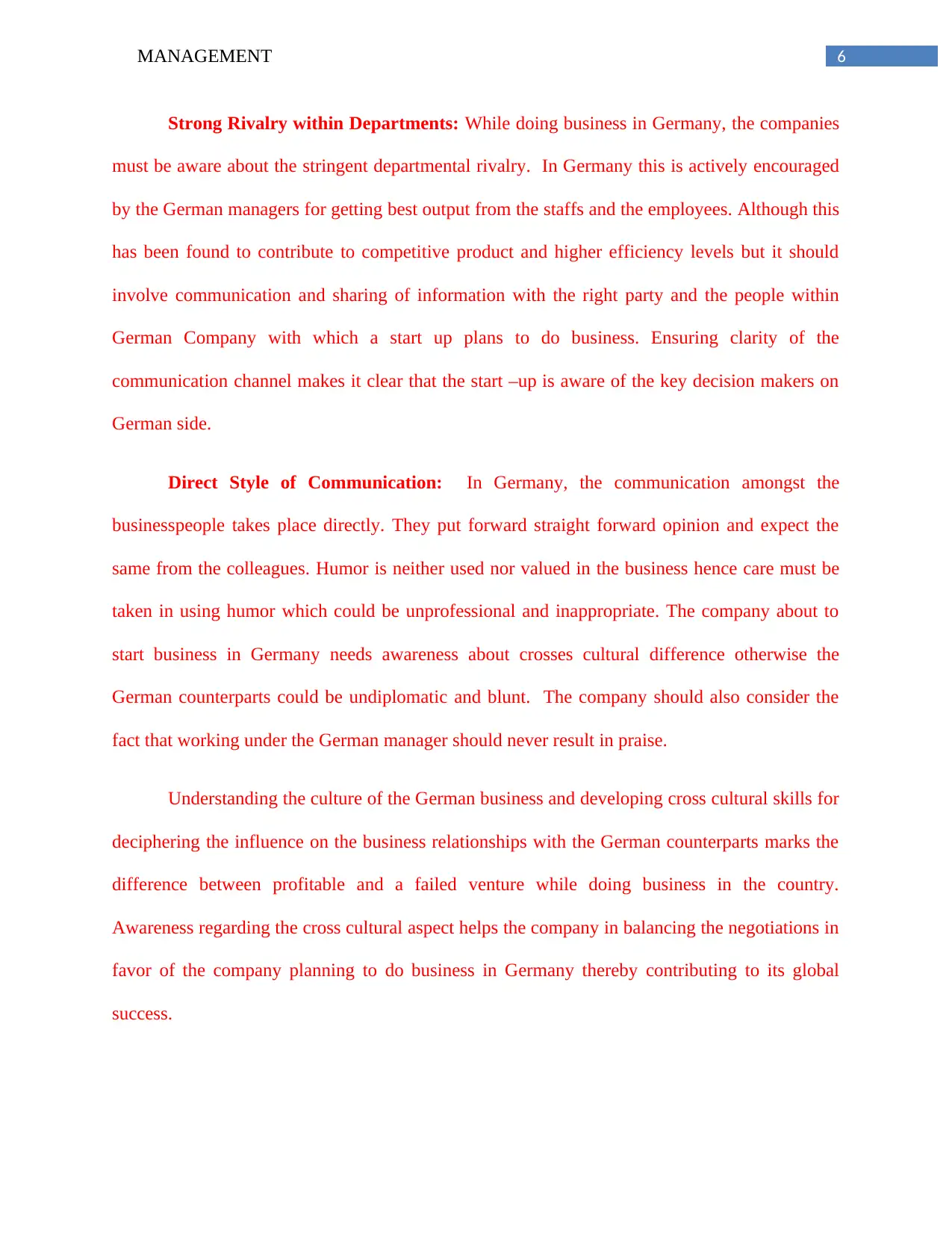
6MANAGEMENT
Strong Rivalry within Departments: While doing business in Germany, the companies
must be aware about the stringent departmental rivalry. In Germany this is actively encouraged
by the German managers for getting best output from the staffs and the employees. Although this
has been found to contribute to competitive product and higher efficiency levels but it should
involve communication and sharing of information with the right party and the people within
German Company with which a start up plans to do business. Ensuring clarity of the
communication channel makes it clear that the start –up is aware of the key decision makers on
German side.
Direct Style of Communication: In Germany, the communication amongst the
businesspeople takes place directly. They put forward straight forward opinion and expect the
same from the colleagues. Humor is neither used nor valued in the business hence care must be
taken in using humor which could be unprofessional and inappropriate. The company about to
start business in Germany needs awareness about crosses cultural difference otherwise the
German counterparts could be undiplomatic and blunt. The company should also consider the
fact that working under the German manager should never result in praise.
Understanding the culture of the German business and developing cross cultural skills for
deciphering the influence on the business relationships with the German counterparts marks the
difference between profitable and a failed venture while doing business in the country.
Awareness regarding the cross cultural aspect helps the company in balancing the negotiations in
favor of the company planning to do business in Germany thereby contributing to its global
success.
Strong Rivalry within Departments: While doing business in Germany, the companies
must be aware about the stringent departmental rivalry. In Germany this is actively encouraged
by the German managers for getting best output from the staffs and the employees. Although this
has been found to contribute to competitive product and higher efficiency levels but it should
involve communication and sharing of information with the right party and the people within
German Company with which a start up plans to do business. Ensuring clarity of the
communication channel makes it clear that the start –up is aware of the key decision makers on
German side.
Direct Style of Communication: In Germany, the communication amongst the
businesspeople takes place directly. They put forward straight forward opinion and expect the
same from the colleagues. Humor is neither used nor valued in the business hence care must be
taken in using humor which could be unprofessional and inappropriate. The company about to
start business in Germany needs awareness about crosses cultural difference otherwise the
German counterparts could be undiplomatic and blunt. The company should also consider the
fact that working under the German manager should never result in praise.
Understanding the culture of the German business and developing cross cultural skills for
deciphering the influence on the business relationships with the German counterparts marks the
difference between profitable and a failed venture while doing business in the country.
Awareness regarding the cross cultural aspect helps the company in balancing the negotiations in
favor of the company planning to do business in Germany thereby contributing to its global
success.
Paraphrase This Document
Need a fresh take? Get an instant paraphrase of this document with our AI Paraphraser
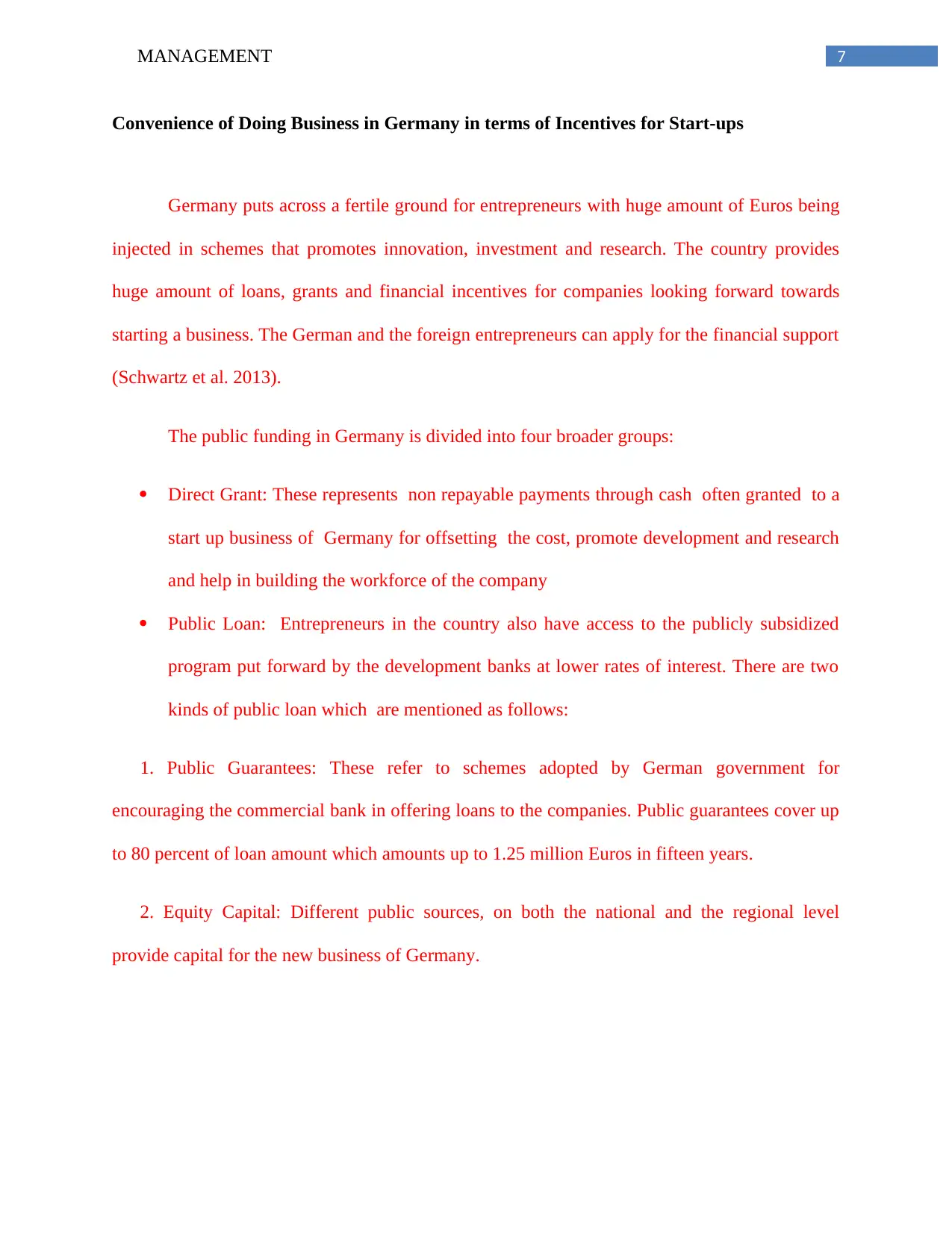
7MANAGEMENT
Convenience of Doing Business in Germany in terms of Incentives for Start-ups
Germany puts across a fertile ground for entrepreneurs with huge amount of Euros being
injected in schemes that promotes innovation, investment and research. The country provides
huge amount of loans, grants and financial incentives for companies looking forward towards
starting a business. The German and the foreign entrepreneurs can apply for the financial support
(Schwartz et al. 2013).
The public funding in Germany is divided into four broader groups:
Direct Grant: These represents non repayable payments through cash often granted to a
start up business of Germany for offsetting the cost, promote development and research
and help in building the workforce of the company
Public Loan: Entrepreneurs in the country also have access to the publicly subsidized
program put forward by the development banks at lower rates of interest. There are two
kinds of public loan which are mentioned as follows:
1. Public Guarantees: These refer to schemes adopted by German government for
encouraging the commercial bank in offering loans to the companies. Public guarantees cover up
to 80 percent of loan amount which amounts up to 1.25 million Euros in fifteen years.
2. Equity Capital: Different public sources, on both the national and the regional level
provide capital for the new business of Germany.
Convenience of Doing Business in Germany in terms of Incentives for Start-ups
Germany puts across a fertile ground for entrepreneurs with huge amount of Euros being
injected in schemes that promotes innovation, investment and research. The country provides
huge amount of loans, grants and financial incentives for companies looking forward towards
starting a business. The German and the foreign entrepreneurs can apply for the financial support
(Schwartz et al. 2013).
The public funding in Germany is divided into four broader groups:
Direct Grant: These represents non repayable payments through cash often granted to a
start up business of Germany for offsetting the cost, promote development and research
and help in building the workforce of the company
Public Loan: Entrepreneurs in the country also have access to the publicly subsidized
program put forward by the development banks at lower rates of interest. There are two
kinds of public loan which are mentioned as follows:
1. Public Guarantees: These refer to schemes adopted by German government for
encouraging the commercial bank in offering loans to the companies. Public guarantees cover up
to 80 percent of loan amount which amounts up to 1.25 million Euros in fifteen years.
2. Equity Capital: Different public sources, on both the national and the regional level
provide capital for the new business of Germany.
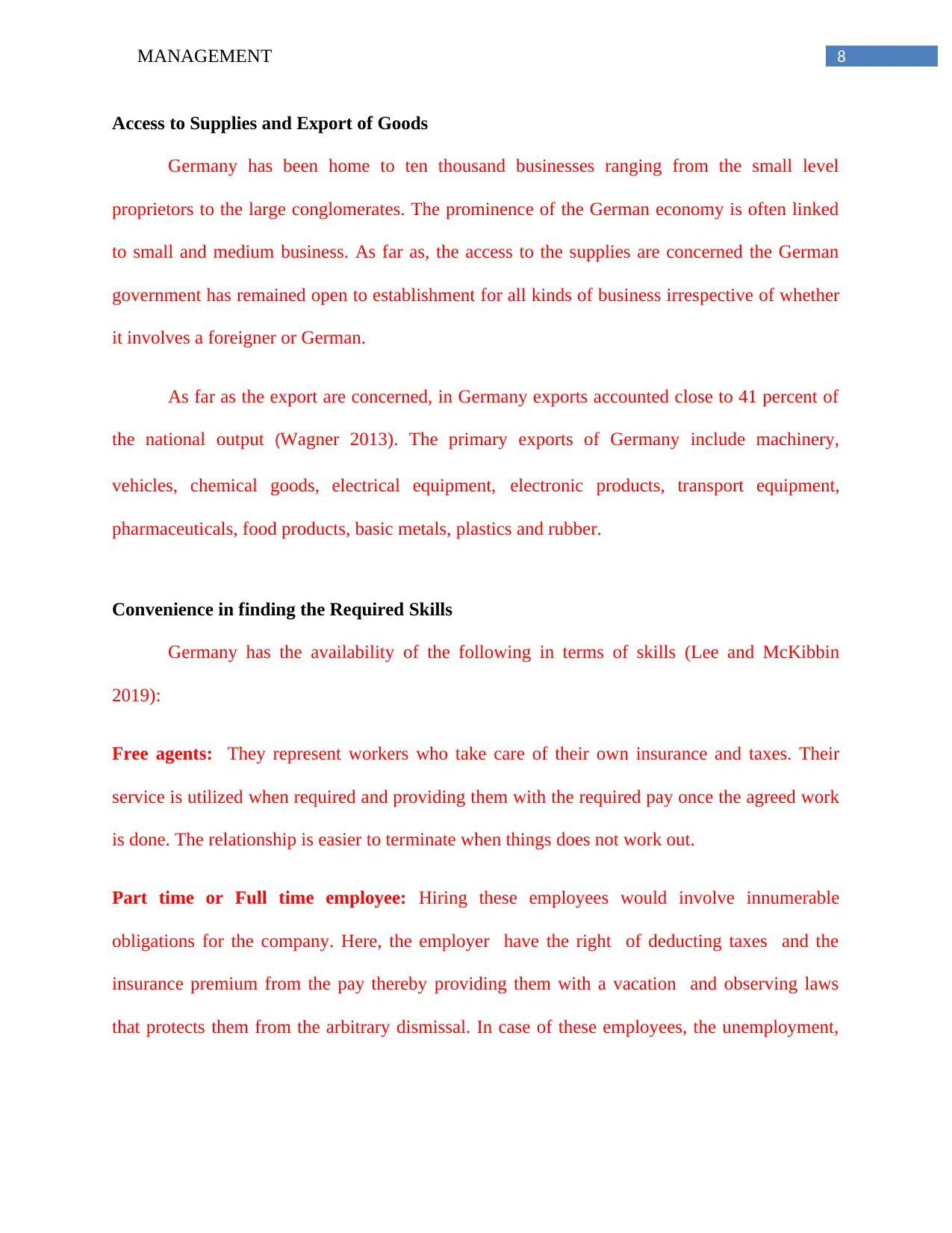
8MANAGEMENT
Access to Supplies and Export of Goods
Germany has been home to ten thousand businesses ranging from the small level
proprietors to the large conglomerates. The prominence of the German economy is often linked
to small and medium business. As far as, the access to the supplies are concerned the German
government has remained open to establishment for all kinds of business irrespective of whether
it involves a foreigner or German.
As far as the export are concerned, in Germany exports accounted close to 41 percent of
the national output (Wagner 2013). The primary exports of Germany include machinery,
vehicles, chemical goods, electrical equipment, electronic products, transport equipment,
pharmaceuticals, food products, basic metals, plastics and rubber.
Convenience in finding the Required Skills
Germany has the availability of the following in terms of skills (Lee and McKibbin
2019):
Free agents: They represent workers who take care of their own insurance and taxes. Their
service is utilized when required and providing them with the required pay once the agreed work
is done. The relationship is easier to terminate when things does not work out.
Part time or Full time employee: Hiring these employees would involve innumerable
obligations for the company. Here, the employer have the right of deducting taxes and the
insurance premium from the pay thereby providing them with a vacation and observing laws
that protects them from the arbitrary dismissal. In case of these employees, the unemployment,
Access to Supplies and Export of Goods
Germany has been home to ten thousand businesses ranging from the small level
proprietors to the large conglomerates. The prominence of the German economy is often linked
to small and medium business. As far as, the access to the supplies are concerned the German
government has remained open to establishment for all kinds of business irrespective of whether
it involves a foreigner or German.
As far as the export are concerned, in Germany exports accounted close to 41 percent of
the national output (Wagner 2013). The primary exports of Germany include machinery,
vehicles, chemical goods, electrical equipment, electronic products, transport equipment,
pharmaceuticals, food products, basic metals, plastics and rubber.
Convenience in finding the Required Skills
Germany has the availability of the following in terms of skills (Lee and McKibbin
2019):
Free agents: They represent workers who take care of their own insurance and taxes. Their
service is utilized when required and providing them with the required pay once the agreed work
is done. The relationship is easier to terminate when things does not work out.
Part time or Full time employee: Hiring these employees would involve innumerable
obligations for the company. Here, the employer have the right of deducting taxes and the
insurance premium from the pay thereby providing them with a vacation and observing laws
that protects them from the arbitrary dismissal. In case of these employees, the unemployment,
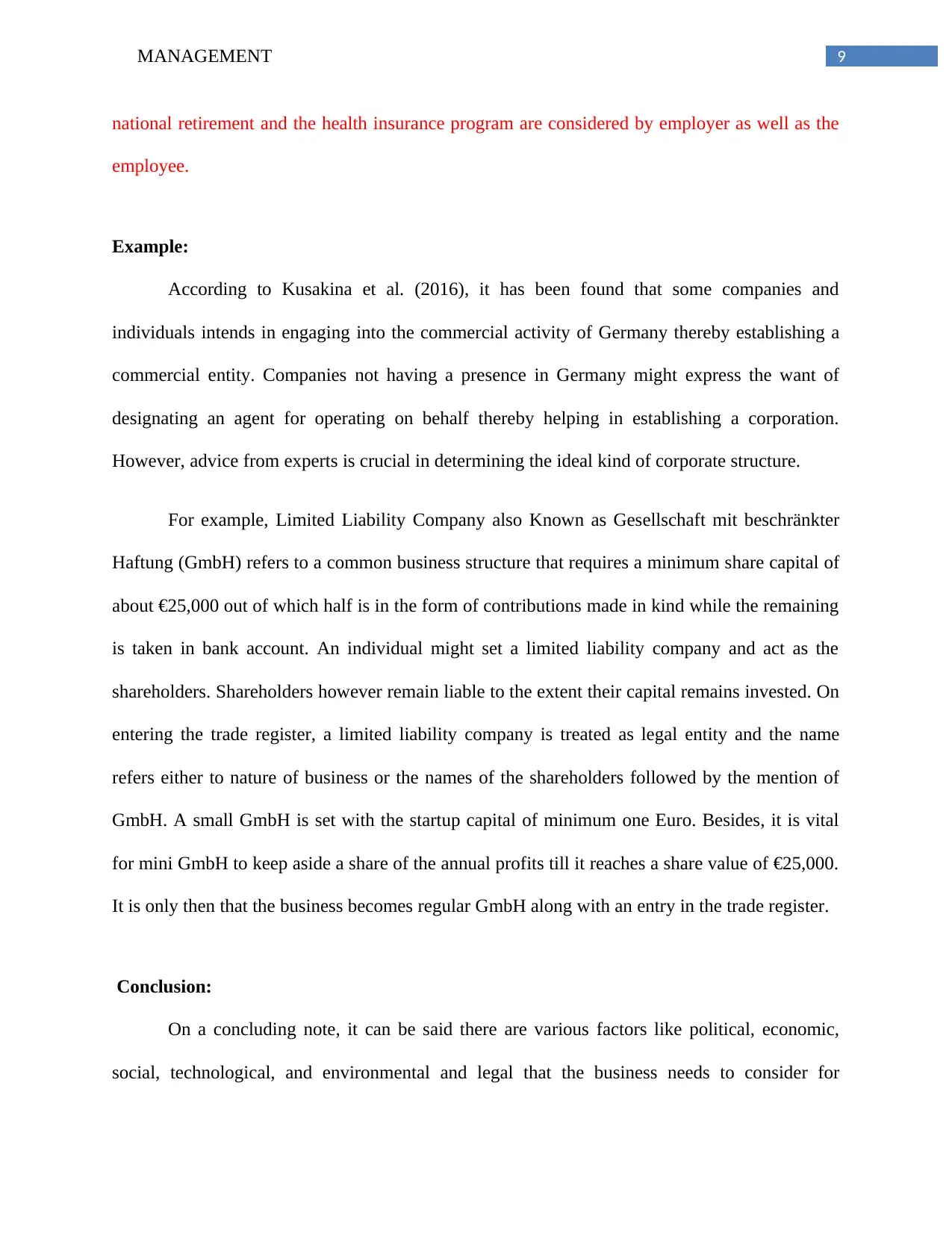
9MANAGEMENT
national retirement and the health insurance program are considered by employer as well as the
employee.
Example:
According to Kusakina et al. (2016), it has been found that some companies and
individuals intends in engaging into the commercial activity of Germany thereby establishing a
commercial entity. Companies not having a presence in Germany might express the want of
designating an agent for operating on behalf thereby helping in establishing a corporation.
However, advice from experts is crucial in determining the ideal kind of corporate structure.
For example, Limited Liability Company also Known as Gesellschaft mit beschränkter
Haftung (GmbH) refers to a common business structure that requires a minimum share capital of
about €25,000 out of which half is in the form of contributions made in kind while the remaining
is taken in bank account. An individual might set a limited liability company and act as the
shareholders. Shareholders however remain liable to the extent their capital remains invested. On
entering the trade register, a limited liability company is treated as legal entity and the name
refers either to nature of business or the names of the shareholders followed by the mention of
GmbH. A small GmbH is set with the startup capital of minimum one Euro. Besides, it is vital
for mini GmbH to keep aside a share of the annual profits till it reaches a share value of €25,000.
It is only then that the business becomes regular GmbH along with an entry in the trade register.
Conclusion:
On a concluding note, it can be said there are various factors like political, economic,
social, technological, and environmental and legal that the business needs to consider for
national retirement and the health insurance program are considered by employer as well as the
employee.
Example:
According to Kusakina et al. (2016), it has been found that some companies and
individuals intends in engaging into the commercial activity of Germany thereby establishing a
commercial entity. Companies not having a presence in Germany might express the want of
designating an agent for operating on behalf thereby helping in establishing a corporation.
However, advice from experts is crucial in determining the ideal kind of corporate structure.
For example, Limited Liability Company also Known as Gesellschaft mit beschränkter
Haftung (GmbH) refers to a common business structure that requires a minimum share capital of
about €25,000 out of which half is in the form of contributions made in kind while the remaining
is taken in bank account. An individual might set a limited liability company and act as the
shareholders. Shareholders however remain liable to the extent their capital remains invested. On
entering the trade register, a limited liability company is treated as legal entity and the name
refers either to nature of business or the names of the shareholders followed by the mention of
GmbH. A small GmbH is set with the startup capital of minimum one Euro. Besides, it is vital
for mini GmbH to keep aside a share of the annual profits till it reaches a share value of €25,000.
It is only then that the business becomes regular GmbH along with an entry in the trade register.
Conclusion:
On a concluding note, it can be said there are various factors like political, economic,
social, technological, and environmental and legal that the business needs to consider for
Secure Best Marks with AI Grader
Need help grading? Try our AI Grader for instant feedback on your assignments.
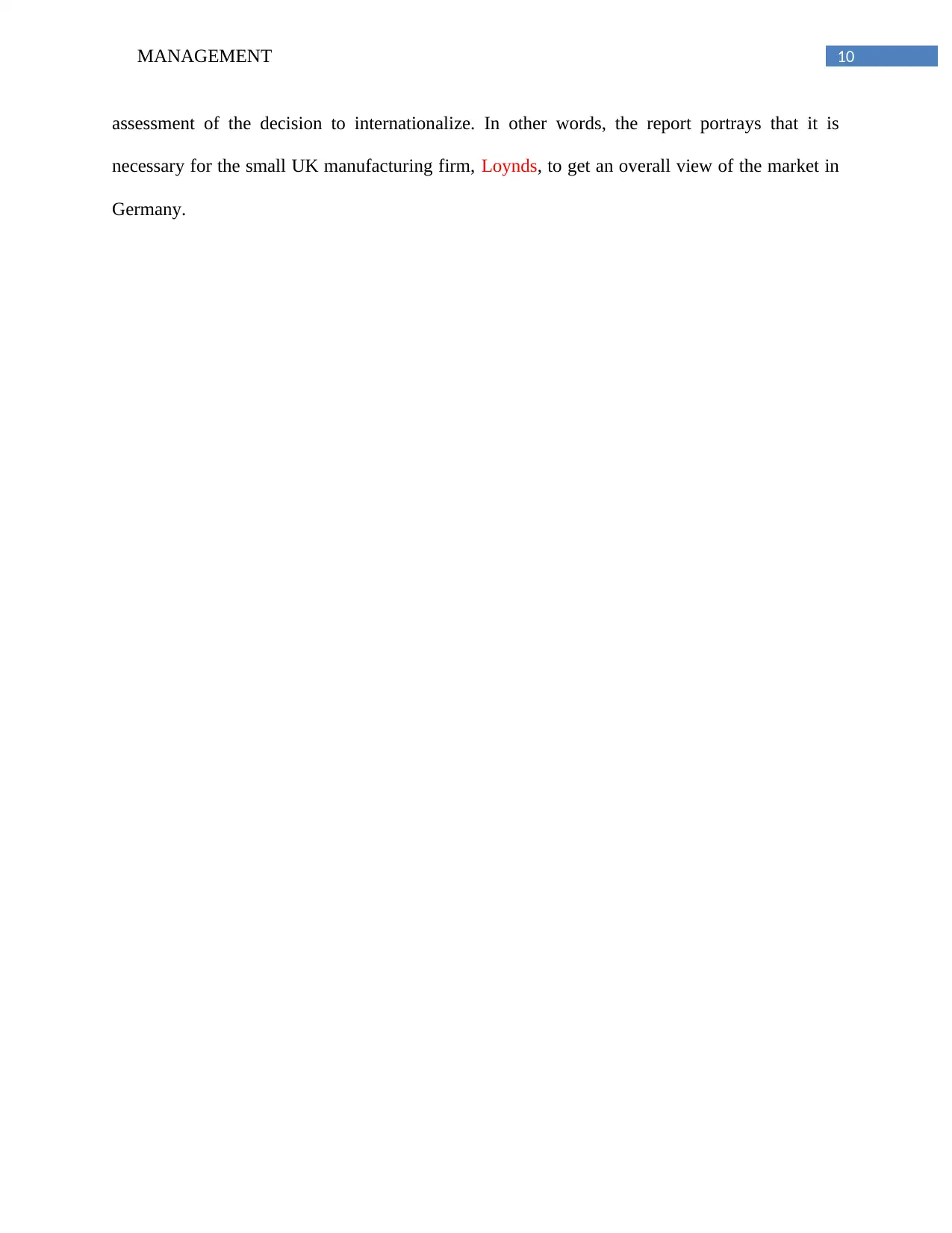
10MANAGEMENT
assessment of the decision to internationalize. In other words, the report portrays that it is
necessary for the small UK manufacturing firm, Loynds, to get an overall view of the market in
Germany.
assessment of the decision to internationalize. In other words, the report portrays that it is
necessary for the small UK manufacturing firm, Loynds, to get an overall view of the market in
Germany.
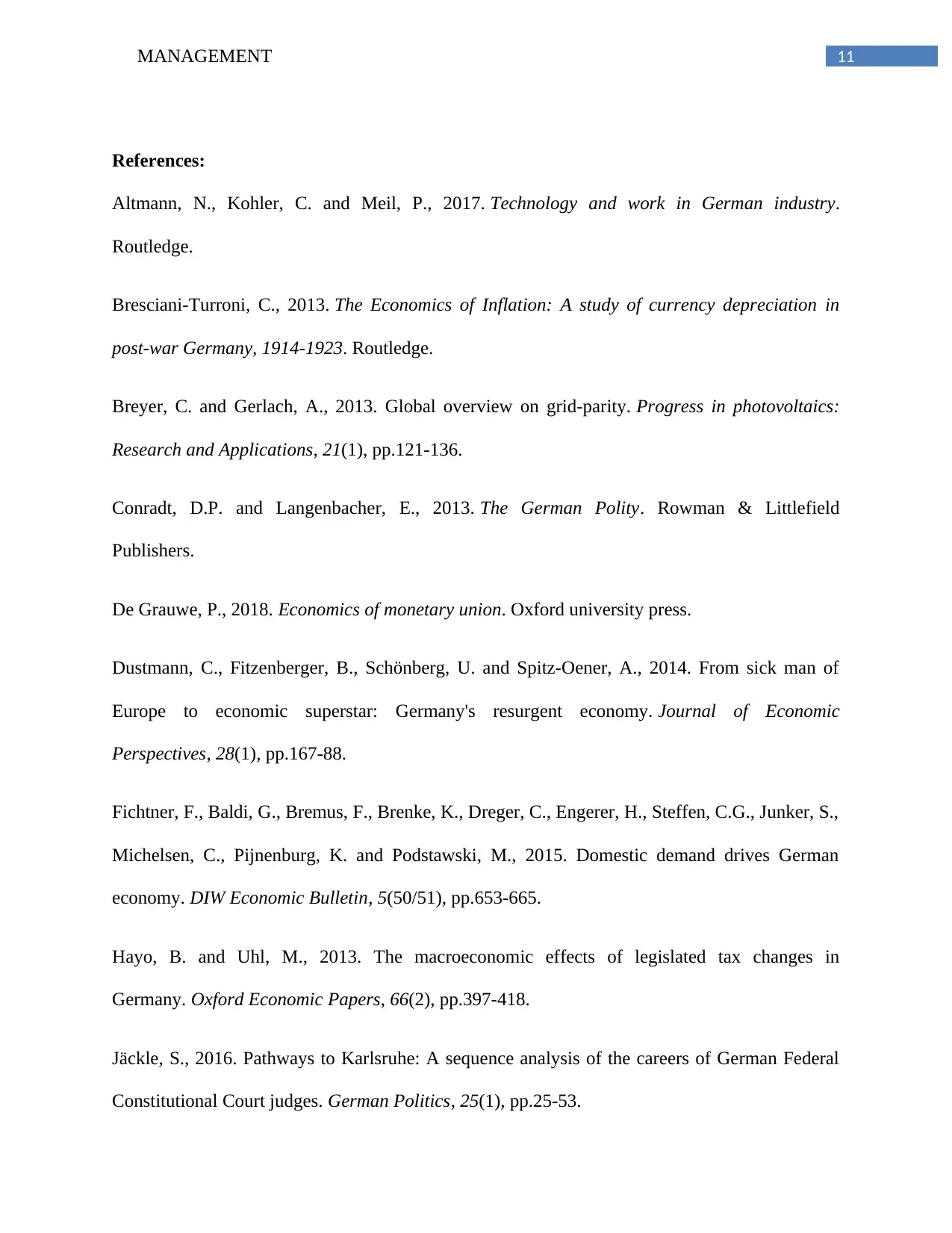
11MANAGEMENT
References:
Altmann, N., Kohler, C. and Meil, P., 2017. Technology and work in German industry.
Routledge.
Bresciani-Turroni, C., 2013. The Economics of Inflation: A study of currency depreciation in
post-war Germany, 1914-1923. Routledge.
Breyer, C. and Gerlach, A., 2013. Global overview on grid‐parity. Progress in photovoltaics:
Research and Applications, 21(1), pp.121-136.
Conradt, D.P. and Langenbacher, E., 2013. The German Polity. Rowman & Littlefield
Publishers.
De Grauwe, P., 2018. Economics of monetary union. Oxford university press.
Dustmann, C., Fitzenberger, B., Schönberg, U. and Spitz-Oener, A., 2014. From sick man of
Europe to economic superstar: Germany's resurgent economy. Journal of Economic
Perspectives, 28(1), pp.167-88.
Fichtner, F., Baldi, G., Bremus, F., Brenke, K., Dreger, C., Engerer, H., Steffen, C.G., Junker, S.,
Michelsen, C., Pijnenburg, K. and Podstawski, M., 2015. Domestic demand drives German
economy. DIW Economic Bulletin, 5(50/51), pp.653-665.
Hayo, B. and Uhl, M., 2013. The macroeconomic effects of legislated tax changes in
Germany. Oxford Economic Papers, 66(2), pp.397-418.
Jäckle, S., 2016. Pathways to Karlsruhe: A sequence analysis of the careers of German Federal
Constitutional Court judges. German Politics, 25(1), pp.25-53.
References:
Altmann, N., Kohler, C. and Meil, P., 2017. Technology and work in German industry.
Routledge.
Bresciani-Turroni, C., 2013. The Economics of Inflation: A study of currency depreciation in
post-war Germany, 1914-1923. Routledge.
Breyer, C. and Gerlach, A., 2013. Global overview on grid‐parity. Progress in photovoltaics:
Research and Applications, 21(1), pp.121-136.
Conradt, D.P. and Langenbacher, E., 2013. The German Polity. Rowman & Littlefield
Publishers.
De Grauwe, P., 2018. Economics of monetary union. Oxford university press.
Dustmann, C., Fitzenberger, B., Schönberg, U. and Spitz-Oener, A., 2014. From sick man of
Europe to economic superstar: Germany's resurgent economy. Journal of Economic
Perspectives, 28(1), pp.167-88.
Fichtner, F., Baldi, G., Bremus, F., Brenke, K., Dreger, C., Engerer, H., Steffen, C.G., Junker, S.,
Michelsen, C., Pijnenburg, K. and Podstawski, M., 2015. Domestic demand drives German
economy. DIW Economic Bulletin, 5(50/51), pp.653-665.
Hayo, B. and Uhl, M., 2013. The macroeconomic effects of legislated tax changes in
Germany. Oxford Economic Papers, 66(2), pp.397-418.
Jäckle, S., 2016. Pathways to Karlsruhe: A sequence analysis of the careers of German Federal
Constitutional Court judges. German Politics, 25(1), pp.25-53.
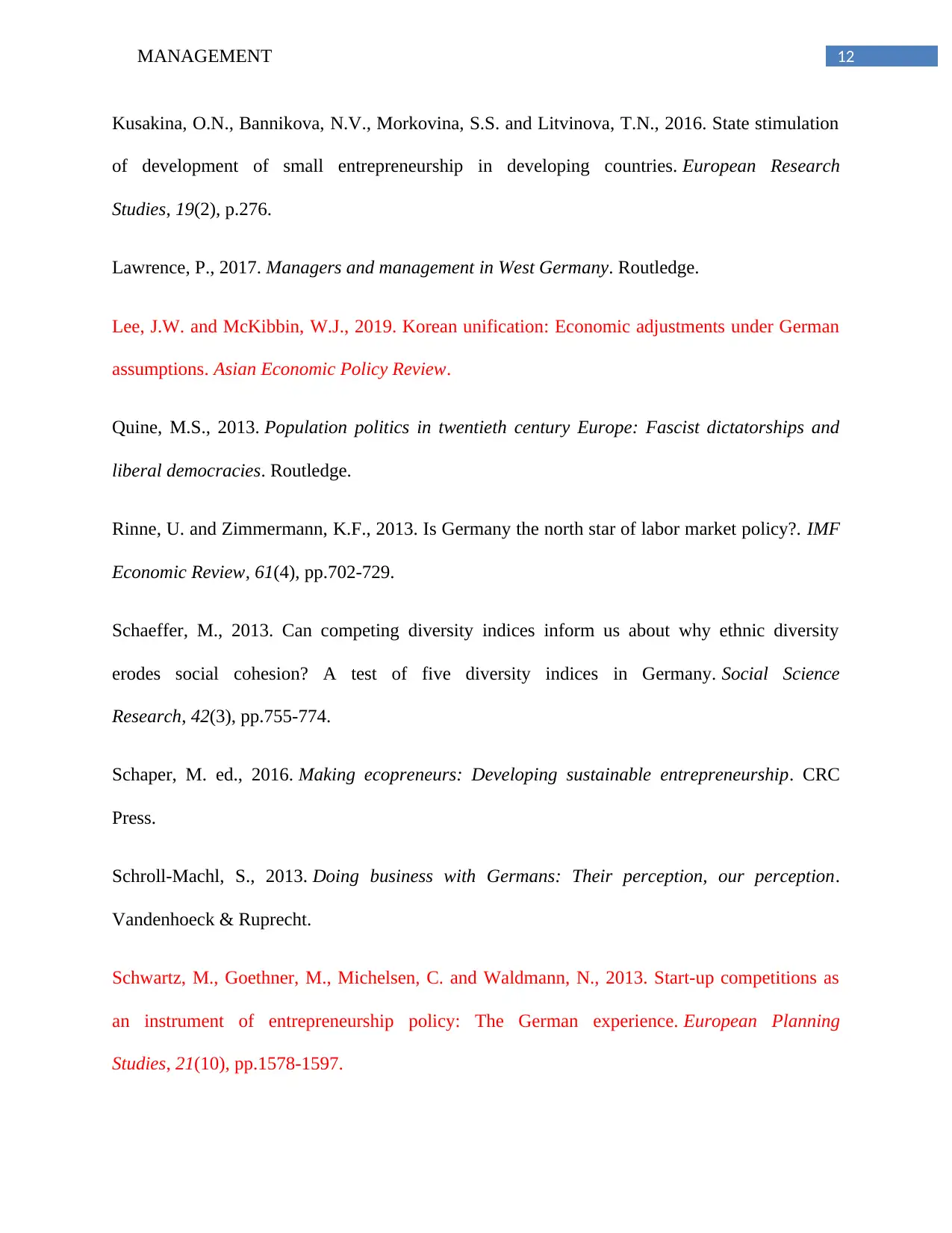
12MANAGEMENT
Kusakina, O.N., Bannikova, N.V., Morkovina, S.S. and Litvinova, T.N., 2016. State stimulation
of development of small entrepreneurship in developing countries. European Research
Studies, 19(2), p.276.
Lawrence, P., 2017. Managers and management in West Germany. Routledge.
Lee, J.W. and McKibbin, W.J., 2019. Korean unification: Economic adjustments under German
assumptions. Asian Economic Policy Review.
Quine, M.S., 2013. Population politics in twentieth century Europe: Fascist dictatorships and
liberal democracies. Routledge.
Rinne, U. and Zimmermann, K.F., 2013. Is Germany the north star of labor market policy?. IMF
Economic Review, 61(4), pp.702-729.
Schaeffer, M., 2013. Can competing diversity indices inform us about why ethnic diversity
erodes social cohesion? A test of five diversity indices in Germany. Social Science
Research, 42(3), pp.755-774.
Schaper, M. ed., 2016. Making ecopreneurs: Developing sustainable entrepreneurship. CRC
Press.
Schroll-Machl, S., 2013. Doing business with Germans: Their perception, our perception.
Vandenhoeck & Ruprecht.
Schwartz, M., Goethner, M., Michelsen, C. and Waldmann, N., 2013. Start-up competitions as
an instrument of entrepreneurship policy: The German experience. European Planning
Studies, 21(10), pp.1578-1597.
Kusakina, O.N., Bannikova, N.V., Morkovina, S.S. and Litvinova, T.N., 2016. State stimulation
of development of small entrepreneurship in developing countries. European Research
Studies, 19(2), p.276.
Lawrence, P., 2017. Managers and management in West Germany. Routledge.
Lee, J.W. and McKibbin, W.J., 2019. Korean unification: Economic adjustments under German
assumptions. Asian Economic Policy Review.
Quine, M.S., 2013. Population politics in twentieth century Europe: Fascist dictatorships and
liberal democracies. Routledge.
Rinne, U. and Zimmermann, K.F., 2013. Is Germany the north star of labor market policy?. IMF
Economic Review, 61(4), pp.702-729.
Schaeffer, M., 2013. Can competing diversity indices inform us about why ethnic diversity
erodes social cohesion? A test of five diversity indices in Germany. Social Science
Research, 42(3), pp.755-774.
Schaper, M. ed., 2016. Making ecopreneurs: Developing sustainable entrepreneurship. CRC
Press.
Schroll-Machl, S., 2013. Doing business with Germans: Their perception, our perception.
Vandenhoeck & Ruprecht.
Schwartz, M., Goethner, M., Michelsen, C. and Waldmann, N., 2013. Start-up competitions as
an instrument of entrepreneurship policy: The German experience. European Planning
Studies, 21(10), pp.1578-1597.
Paraphrase This Document
Need a fresh take? Get an instant paraphrase of this document with our AI Paraphraser
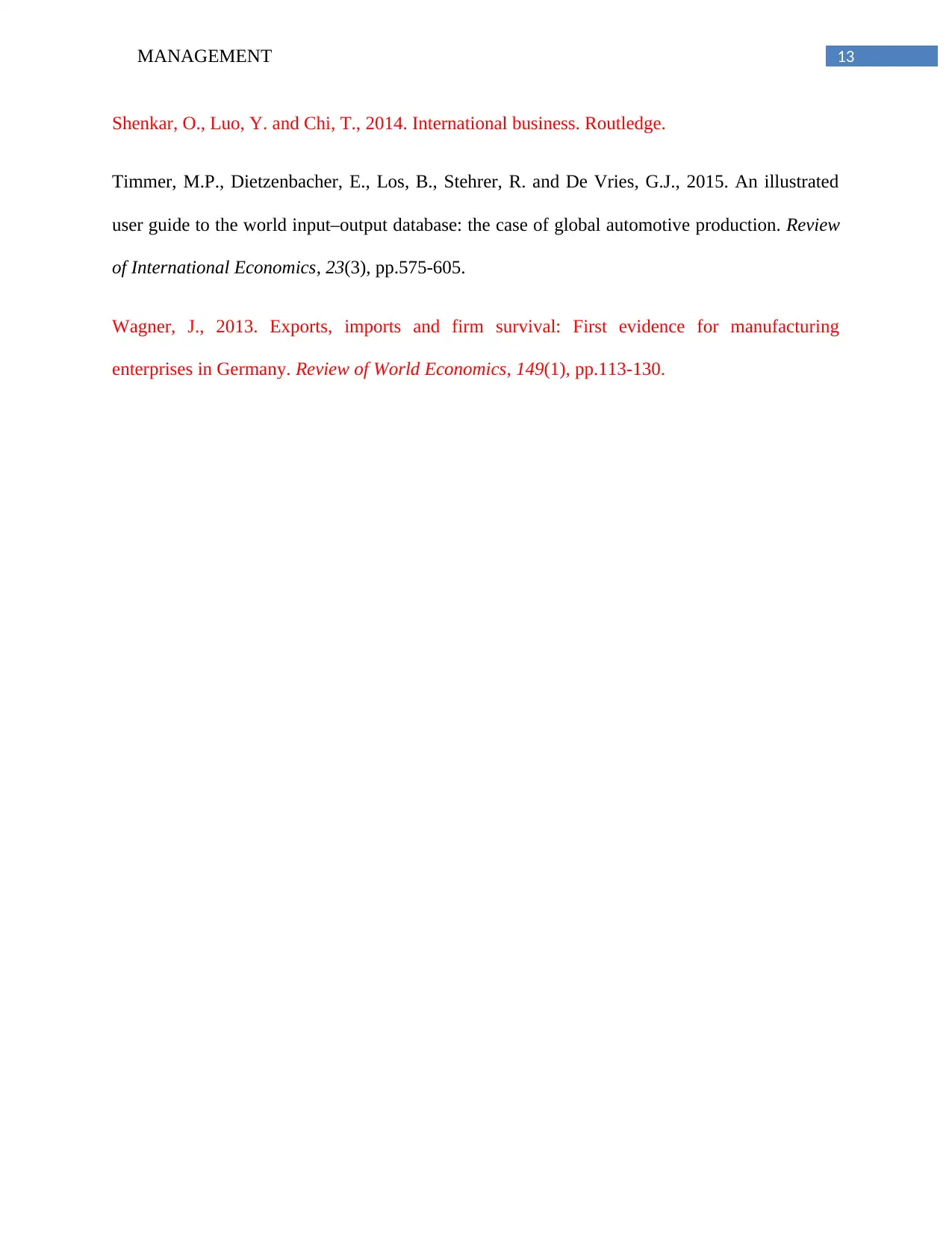
13MANAGEMENT
Shenkar, O., Luo, Y. and Chi, T., 2014. International business. Routledge.
Timmer, M.P., Dietzenbacher, E., Los, B., Stehrer, R. and De Vries, G.J., 2015. An illustrated
user guide to the world input–output database: the case of global automotive production. Review
of International Economics, 23(3), pp.575-605.
Wagner, J., 2013. Exports, imports and firm survival: First evidence for manufacturing
enterprises in Germany. Review of World Economics, 149(1), pp.113-130.
Shenkar, O., Luo, Y. and Chi, T., 2014. International business. Routledge.
Timmer, M.P., Dietzenbacher, E., Los, B., Stehrer, R. and De Vries, G.J., 2015. An illustrated
user guide to the world input–output database: the case of global automotive production. Review
of International Economics, 23(3), pp.575-605.
Wagner, J., 2013. Exports, imports and firm survival: First evidence for manufacturing
enterprises in Germany. Review of World Economics, 149(1), pp.113-130.
1 out of 14
Related Documents
Your All-in-One AI-Powered Toolkit for Academic Success.
+13062052269
info@desklib.com
Available 24*7 on WhatsApp / Email
![[object Object]](/_next/static/media/star-bottom.7253800d.svg)
Unlock your academic potential
© 2024 | Zucol Services PVT LTD | All rights reserved.





